GOCE-Derived Coseismic Gravity Gradient Changes Caused by the 2011 Tohoku-Oki Earthquake
Abstract
:1. Introduction
2. Methodology
2.1. Recovering Gravity Field Model from GOCE SGG Observations
2.2. Tailored Spherical Harmonic Coefficients
2.3. Post-earthquake Gravity Changes from GOCE
2.4. Post-earthquake Gravity Changes from GRACE
2.5. Forward Modeling Coseismic Gravity and Gravity Gradient Changes
2.6. Modeling of Post-seismic Gravity Changes
2.7. Computation of Coseismic Gravity Changes from the Hydrological and Oceanic Mass Redistributions
3. Results
3.1. Coseismic Gravity and Gravity Gradient Changes from the forward-modeled TSH Coefficients
3.2. Post-seismic Gravity Changes from the Viscoelastic Model
3.3. Coseismic Gravity Changes from the Hydrological and Oceanic Mass Redistributions
3.4. GRACE-derived Coseismic Gravity Changes and Gravity Gradient Changes
3.5. GOCE-derived Coseismic Gravity Changes and Gravity Gradient Changes
4. Discussion
- (1)
- A step function s(t) is used to fit the original time series (the earthquake time is used as a priori information in the way some previous studies have done), then the step value s is obtained at the same time.
- (2)
- 300 different random Gaussian white noise time series ni(t) are synthesized, which have the same length, and with the same mean power in the frequency domain (i.e., almost the same noise level; here we use mean power P = 1.3 × 10−2 mE2/cpy; see the supplementary Figure S3). Note that here we ignore the small differences of the oscillation amplitudes in the radial gravity gradient change time series (see Figure 13), because the time points are limited, the 300 different noise time series can almost reproduce all possible different oscillations.
- (3)
- The fitted step function s(t) is added in the 300 noise time series ni(t), and 300 new noisy time series fi(t) = s(t) + ni(t) are obtained.
- (4)
- For the 300 noisy time series fi(t), repeating the process 1) and 2) for all of them, then the 300 new step values si can be estimated. The standard deviation of those different Si is used as the final error estimation for the step value s.
5. Conclusions
Supplementary Materials
Author Contributions
Funding
Acknowledgments
Conflicts of Interest
References
- Reigber, C.; Schwintzer, P.; Neumayer, K.H.; Barthelmes, F.; König, R.; Förste, C.; Balmino, G.; Biancale, R.; Lemoine, J.-M.; Loyer, S.; et al. The CHAMP-only earth gravity field model EIGEN-2. Adv. Space Res. 2003, 31, 1883–1888. [Google Scholar] [CrossRef]
- Tapley, B.D.; Bettadpur, S.; Watkins, M.; Reigber, C. The gravity recovery and climate experiment: Mission overview and early results. Geophys. Res. Lett. 2004, 31, L09607. [Google Scholar] [CrossRef]
- Drinkwater, M.; Haagmans, R.; Muzi, D. The GOCE gravity mission: ESA’s first core explorer. In Proceedings of the Third GOCE User Workshop, Frascati, Italy, 6–9 November 2006; pp. 1–7. [Google Scholar]
- Han, S.C.; Shum, C.K.; Bevis, M.; Ji, C.; Kuo, C.Y. Crustal dilatation observed by GRACE after the 2004 Sumatra-Andaman earthquake. Science 2006, 313, 658–662. [Google Scholar] [CrossRef]
- Chen, J.L.; Wilson, C.R.; Tapley, B.D.; Grand, S. GRACE detects coseismic and postseismic deformation from the Sumatra-Andaman earthquake. Geophys. Res. Lett. 2007, 34, L13302. [Google Scholar] [CrossRef]
- Panet, I.; Pollitz, F.; Mikhailov, V.; Diament, M.; Banerjee, P.; Grijalva, K. Upper mantle rheology from GRACE and GPS postseismic deformation after the 2004 Sumatra-Andaman earthquake. Geochem. Geophys. Geosyst. 2010, 11, Q06008. [Google Scholar] [CrossRef]
- De Linage, C.; Rivera, L.; Hinderer, J.; Boy, J.P.; Rogister, Y.; Lambotte, S.; Biancale, R. Separation of coseismic and postseismic gravity changes for the 2004 Sumatra-Andaman earthquake from 4.6 yr of GRACE observations and modeling of the coseismic change by normal modes summation. Geophys. J. Int. 2009, 176, 695–714. [Google Scholar] [CrossRef]
- Han, S.C.; Sauber, J.; Luthcke, S. Regional gravity decrease after the 2010 Maule (Chile) earthquake indicates large-scale mass redistribution. Geophys. Res. Lett. 2010, 37, L23307. [Google Scholar] [CrossRef]
- Heki, K.; Matsuo, K. Coseismic gravity changes of the 2010 earthquake in central Chile from satellite gravimetry. Geophys. Res. Lett. 2010, 37, L24306. [Google Scholar] [CrossRef]
- Broerse, D.; Vermeersen, L.; Riva, R.; van der Wal, W. Ocean contribution to co-seismic crustal deformation and geoid anomalies: Application to the 2004 December 26 Sumatra-Andaman earthquake. Earth Planet. Sci. Lett. 2011, 305, 341–349. [Google Scholar] [CrossRef]
- Matsuo, K.; Heki, K. Coseismic gravity changes of the 2011 Tohoku-Oki earthquake from satellite gravimetry. Geophys. Res. Lett. 2011, 38, L00G12. [Google Scholar] [CrossRef]
- Han, S.C.; Sauber, J.; Riva., R. Contribution of satellite gravimetry to understanding seismic source processes of the 2011 Tohoku-Oki earthquake. Geophys. Res. Lett. 2011, 38, L24312. [Google Scholar] [CrossRef]
- Wang, L.; Shum, C.K.; Simons, F.J.; Tapley, B.; Dai, C. Coseismic and postseismic deformation of the 2011 Tohoku-Oki earthquake constrained by GRACE gravimetry. Geophys. Res. Lett. 2012, 39, L07301. [Google Scholar] [CrossRef]
- Zhou, X.; Sun, W.; Zhao, B.; Fu, G.; Dong, J.; Nie, Z. Geodetic observations detecting coseismic displacements and gravity changes caused by the Mw = 9.0 Tohoku-Oki earthquake. J. Geophys. Res. 2012, 117, B05408. [Google Scholar] [CrossRef]
- Cambiotti, G.; Sabadini, R. A source model for the great 2011 Tohoku earthquake (Mw = 9.1) from inversion of GRACE gravity data. Earth Planet Sci. Lett. 2012, 335–336, 72–79. [Google Scholar] [CrossRef]
- Dai, C.; Shum, C.K.; Wang, R.; Wang, L.; Guo, J.; Shang, K.; Tapley, B.D. Improved constraints on seismic source parameters of the 2011 Tohoku earthquake from GRACE gravity and gravity gradient changes. Geophys. Res. Lett. 2014, 41, 1929–1936. [Google Scholar] [CrossRef] [Green Version]
- Li, J.; Shen, W.B. Monthly GRACE detection of coseismic gravity change associated with 2011 Tohoku-Oki earthquake using northern gradient approach. Earth Planets Space 2015, 67, 29. [Google Scholar] [CrossRef]
- Odera, P.A.; Fukuda, Y. Evaluation of GOCE-based global gravity field models over Japan after the full mission using free-air gravity anomalies and geoid undulations. Earth Planets Space 2017, 69, 135. [Google Scholar] [CrossRef] [Green Version]
- Gilardoni, M.; Reguzzoni, M.; Sampietro, D.; Sansò, F. Combining EGM2008 with GOCE gravity models. Bollettino di Geofisica Teorica ed Applicata 2013, 54, 285–302. [Google Scholar]
- Bouman, J.; Ebbing, J.; Martin Fuchs, M.J.; Sebera, J.; Lieb, V.; Szwillus, W.; Haagmans, R.; Novak, P. Satellite gravity gradient grids for geophysics. Sci. Rep. 2016, 6, 21050. [Google Scholar] [CrossRef] [Green Version]
- Bouman, J.; Ebbing, J.; Meekes, S.; Fattah, R.A.; Fuchs, M.; Gradmann, S.; Haagmans, R.; Lieb, V.; Schmidt, M.; Dettmering, D.; et al. GOCE gravity gradient data for lithospheric modeling. Int. J. Appl. Earth Obs. 2015, 35, 16–30. [Google Scholar] [CrossRef]
- Reguzzoni, M.; Sampietro, D. GEMMA: An Earth crustal model based on GOCE satellite data. Int. J. Appl. Earth Obs. 2015, 35, 31–43. [Google Scholar] [CrossRef]
- Bingham, R.J.; Haines, K.; Lea, D. A comparison of GOCE and drifter-based estimates of the North Atlantic steady-state surface circulation. Int. J. Appl. Earth Obs. 2015, 35, 140–150. [Google Scholar] [CrossRef]
- Mikhailov, V.; Tikhotsky, S.; Diament, M.; Panet, I.; Ballu, V. Can tectonic processes be recovered from new gravity satellite data? Earth Planet Sci. Lett. 2004, 228, 281–297. [Google Scholar] [CrossRef]
- Migliaccio, F.; Reguzzoni, M.; Sansò, F.; Dalla Via, G.; Sabadini, R. Detecting geophysical signals in gravity satellite missions. Geophys. J. Int. 2008, 172, 56–66. [Google Scholar] [CrossRef] [Green Version]
- Han, S.-C.; Ditmar, P. Localized spectral analysis of global satellite gravity fields for recovering time-variable mass redistributions. J. Geod. 2008, 82, 423–430. [Google Scholar] [CrossRef]
- Garcia, R.F.; Bruinsma, S.; Lognonné, P.; Doornbos, E.; Cachoux, F. GOCE: The First Seismometer in Orbit around the Earth. Geophys. Res. Lett. 2013. [Google Scholar] [CrossRef]
- Fuchs, M.J.; Bouman, J.; Broerse, T.; Visser, P.; Vermeersen, B. Observing coseismic gravity change from the Japan Tohoku-Oki 2011 earthquake with GOCE gravity gradiometry. J. Geophys. Res. Solid Earth. 2013, 118, 5712–5721. [Google Scholar] [CrossRef] [Green Version]
- Fuchs, M.J.; Hooper, A.; Broerse, T.; Bouman, J. Distributed fault slip model for the 2011 Tohoku-Oki earthquake from GNSS and GRACE/GOCE satellite gravimetry. J. Geophys. Res. Solid Earth. 2016, 121, 1114–1130. [Google Scholar] [CrossRef]
- Han, S.C.; Shum, C.K.; Ditmar, P.; Visser, P.; van Beelen, C.; Schrama, E.J.O. Effect of high-frequency mass variations on GOCE recovery of the Earth’s gravity field. J. Geodyn. 2006, 41, 69–76. [Google Scholar] [CrossRef]
- Bouman, J.; Fiorot, S.; Fuchs, M.; Gruber, T.; Schrama, E.; Tscherning, C.C.; Veicherts, M.; Visser, P. GOCE gravity gradients along the orbit. J. Geod. 2011, 85, 791–805. [Google Scholar] [CrossRef]
- Mayer-Gürr, T.; Rieser, D.; Hoeck, E.; Brockmann, J.M.; Schuh, W.-D.; Krasbutter, I.; Kusche, J.; Maier, A.; Krauss, S.; Hausleitner, W.; et al. The new combined satellite only model GOCO03s. Presented at the GGHS2012, Venice, Italy, 9–12 November 2012. [Google Scholar]
- Xu, X.; Zhao, Y.; Reubelt, T.; Tenzer, R. A GOCE only gravity model GOSG01S and the validation of GOCE related satellite gravity models. Geod. Geodyn. 2017, 8, 260–272. [Google Scholar] [CrossRef]
- Koop, R. Global Gravity Field Modeling Using Satellite Gravity Gradiometry; Publications on Geodesy, New Series, Number 38; Netherlands Geodetic Commission: Delft, The Netherlands, 1993. [Google Scholar]
- Cesare, S. Performance Requirements and Budgets for the Gradiometric Mission; Technical Note, GOC-TN-AI-0027; Alenia Spazio: Turin, Italy, 2008. [Google Scholar]
- Schuh, W.D. Improved modelling of SGG-data sets by advanced filter strategies. In ESA-Project “From Eötvös to mGal+”; Final Report, ESA/ESTEC Contract 14287/00/NL/DC, WP 2; ESA: Noordwijk, The Netherlands, 2002; pp. 113–181. [Google Scholar]
- Fuchs, M.; Bouman, J. Rotation of GOCE gravity gradients to local frames. Geophys. J. Int. 2011, 187, 743–753. [Google Scholar] [CrossRef] [Green Version]
- Rummel, R.; Yi, W.; Stummer, C. GOCE gravitational gradiometry. J. Geod. 2011, 85, 777–790. [Google Scholar] [CrossRef]
- Sneeuw, N.; van Gelderen, M. The polar gap. In Geodetic Boundary Value Problems in View of the One Centimeter Geoid; Sansò, F., Rummel, R., Eds.; Lecture Notes in Earth Sciences; Springer: Berlin, Germany, 1997; Volume 65, pp. 559–568. [Google Scholar]
- EGG-C. GOCE Level 2 Product Data Handbook; GO-MA-HPF-GS-0110. 2010. Available online: https://earth.esa.int/web/guest/document-library/browse-document-library/-/article/goce-level-2-product-data-handbook-5713 (accessed on 12 May 2017).
- Wang, R.; Lorenzo-Martiín, F.; Roth, F. PSGRN/PSCMP—A new code for calculating co- and post-seismic deformation, geoid and gravity changes based on the viscoelastic-gravitational dislocation theory. Comput. Geosci. 2006, 32, 527–541. [Google Scholar] [CrossRef]
- Wei, S.; Sladen, A.; The ARIA Group. Updated Result: 3/11/2011 (Mw 9.0), Tohoku-Oki, Japan. 2011. Available online: http://www.tectonics.caltech.edu/slip_history/2011_taiheiyo-oki/ (accessed on 18 June 2015).
- Bassin, C.; Laske, G.; Masters, G.G. The current limits of resolution for surface wave tomography in North America. EOS Trans. 2000, 81, F897. [Google Scholar]
- Broerse, T.; Riva, R.; Vermeersen, B. Ocean contribution to seismic gravity changes: The sea level equation for seismic perturbations revisited. Geophys. J. Int. 2014, 199, 1094–1109. [Google Scholar] [CrossRef]
- Colombo, O. Numerical Methods for Harmonic Analysis on the Sphere; Report No. 310; Dept. of Geodetic Science and Surveying, Ohio State University: Columbus, OH, USA, 1981. [Google Scholar]
- Han, S.-C.; Sauber, J.; Pollitz, F. Broadscale postseismic gravity change following the 2011 Tohoku-Oki earthquake and implication for deformation by viscoelastic relaxation and afterslip. Geophys. Res. Lett. 2014, 41, 5797–5805. [Google Scholar] [CrossRef]
- Bouman, J.; Rispens, S.; Gruber, T.; Koop, R.; Schrama, E.; Visser, P.; Tscherning, C.C.; Veicherts, M. Preprocessing of gravity gradients at the GOCE high-level processing facility. J. Geod. 2009, 83, 659–678. [Google Scholar] [CrossRef]
- Fukumori, I. A partitioned Kalman filter and smoother. Mon. Weather Rev. 2002, 130, 1370–1383. [Google Scholar] [CrossRef]
- Kim, S.B.; Lee, T.; Fukumori, I. Mechanisms Controlling the Interannual Variation of Mixed Layer Temperature Averaged over the Niño-3 Region. J. Clim. 2007, 20, 3822–3843. [Google Scholar] [CrossRef]
- Rodell, M.; Houser, P.R.; Jambor, U.; Gottschalck, J.; Mitchell, K.; Meng, C.-J.; Arsenault, K.; Cosgrove, B.; Radakovich, J.; Bosilovich, M.; et al. The Global Land Data Assimilation System. Bull. Am. Meteorol. Soc. 2004, 85, 381–394. [Google Scholar] [CrossRef] [Green Version]
- Heki, K.; Mitsui, Y.; Matsuo, K.; Tanaka, Y. Accelerated subduction of the Pacific Plate after mega-thrust earthquakes: Evidence from GPS and GRACE. Presented at the AGU Fall Meeting 2012, San Francisco, CA, USA, 3–7 December 2012. [Google Scholar]
- Feng, W.; Li, Q.; Li, Z.; Hoey, T. Slip distribution of 2011 Japan Mw 9.0 earthquake determined by GPS-coseismic displacement and GRACE gravity changes. Presented at the EGU Scientific Assembly, Vienna, Austria, 7–12 April 2013. [Google Scholar]
- ESA. Available online: https://earth.esa.int/web/sppa/mission-performance/esa-missions/goce/quality -control-reports/daily-egg-quality-overview (accessed on 20 January 2019).
- Han, S.-C.; Sauber, J.; Pollitz, F. Coseismic compression/dilatation and viscoelastic uplift/subsidence following the 2012 Indian Ocean earthquakes quantified from satellite gravity observations. Geophys. Res. Lett. 2015, 42, 3764–3772. [Google Scholar] [CrossRef]
- Chao, B.F.; Liau, J.R. Gravity changes due to large earthquakes detected in GRACE satellite data via empirical orthogonal function analysis. J. Geophys. Res. Solid Earth 2019. [Google Scholar] [CrossRef]
- Efron, B.; Tibshirani, R. Bootstrap methods for standard errors, confidence intervals, and other measures of statistical accuracy. Stat. Sci. 1986, 1, 54–75. [Google Scholar] [CrossRef]
- Widmer-Schnidrig, R.; Masters, G.; Gilbert, F. Observably split multiplets-data analysis and interpretation in terms of large-scale aspherical structure. Geophys. J. Int. 1992, 111, 559–576. [Google Scholar] [CrossRef] [Green Version]
- Häfner, R.; Widmer-Schnidrig, R. Signature of 3-D density structure in spectra of the spheroidal free oscillation 0S2. Geophys. J. Int. 2013, 192, 285–294. [Google Scholar] [CrossRef]
- Shen, W.B.; Ding, H. Observation of spheroidal normal mode multiplets below 1 mHz using ensemble empirical mode decomposition. Geophys. J. Int. 2014, 196, 1631–1642. [Google Scholar] [CrossRef]
- Ding, H.; Chao, B.F. Data stacking methods for isolation of singlets of the Earth’s normal modes: Extensions comparisons and applications. J. Geophys. Res. Solid Earth 2015, 120, 5034–5050. [Google Scholar] [CrossRef]
- Chen, J.L.; Wilson, C.R.; Tapley, B.D. Contribution of ice sheet and mountain glacier melt to recent sea level rise. Nat. Geosci. 2013, 6, 549–552. [Google Scholar] [CrossRef]
- Han, J.; Tangdamrongsub, N.; Hwang, C.; Abidin, H.Z. Intensified water storage loss by biomass burning in Kalimantan: Detection by GRACE. J. Geophys. Res. Solid Earth 2017, 122, 2409–2430. [Google Scholar] [CrossRef]

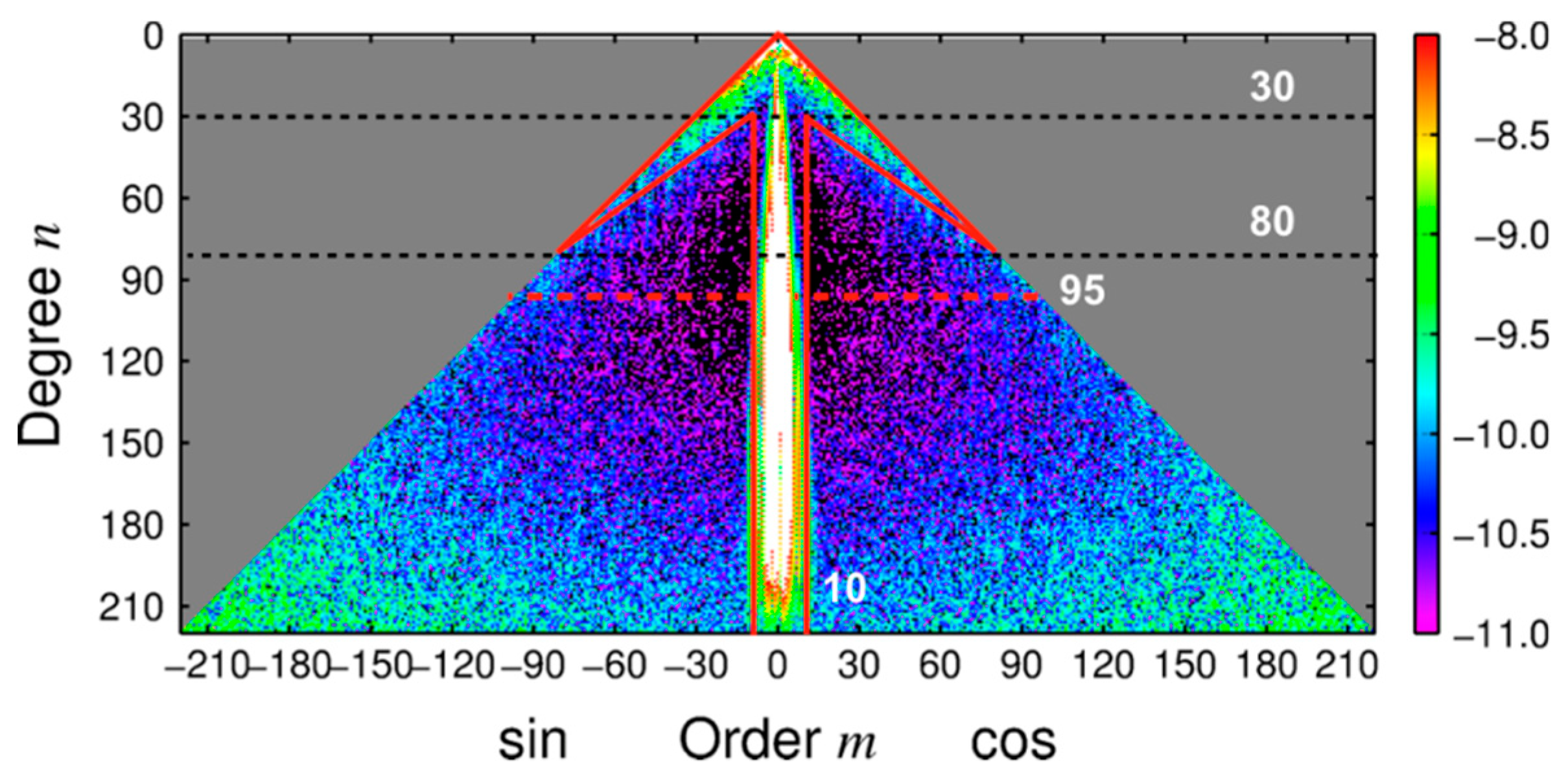


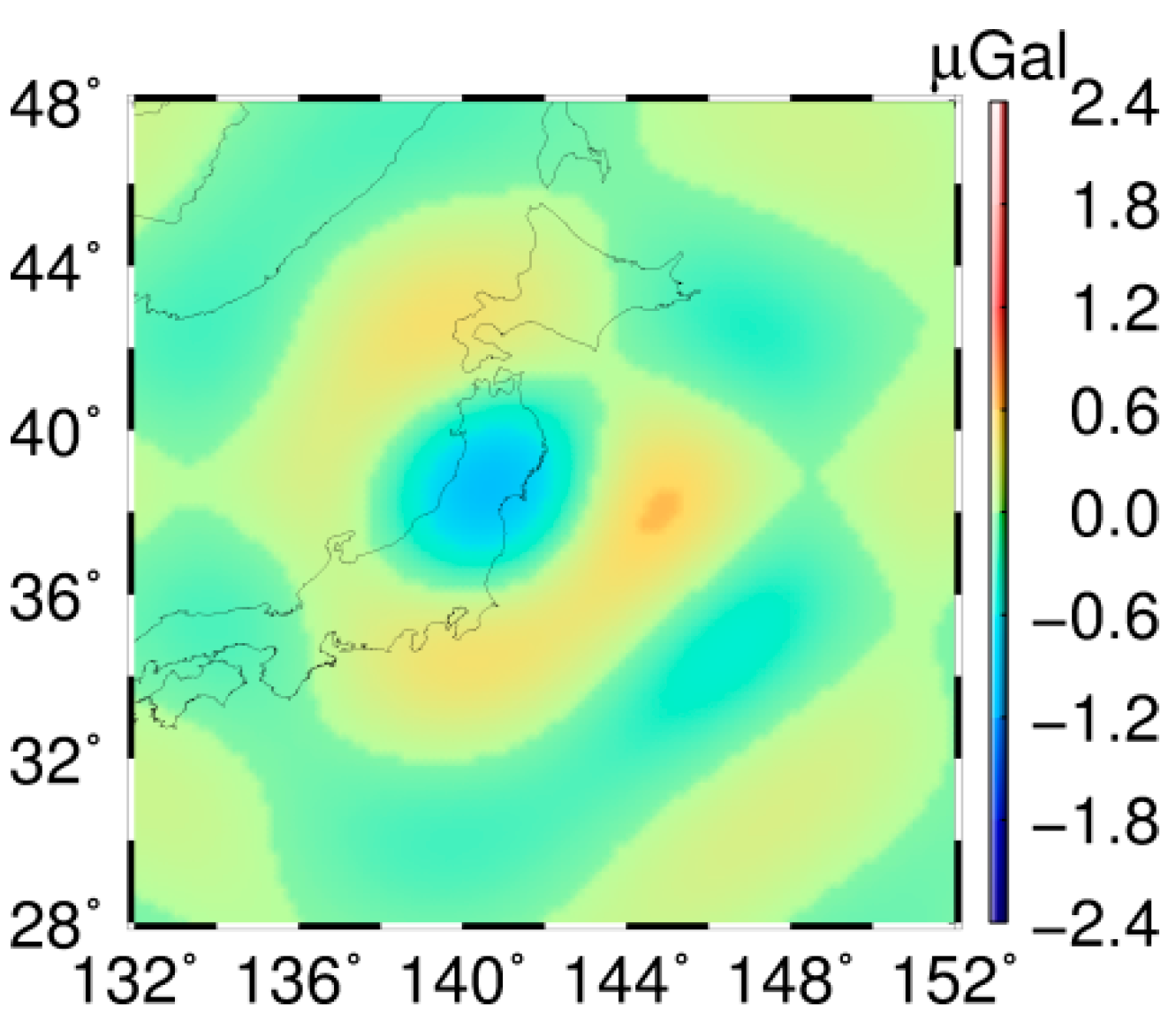

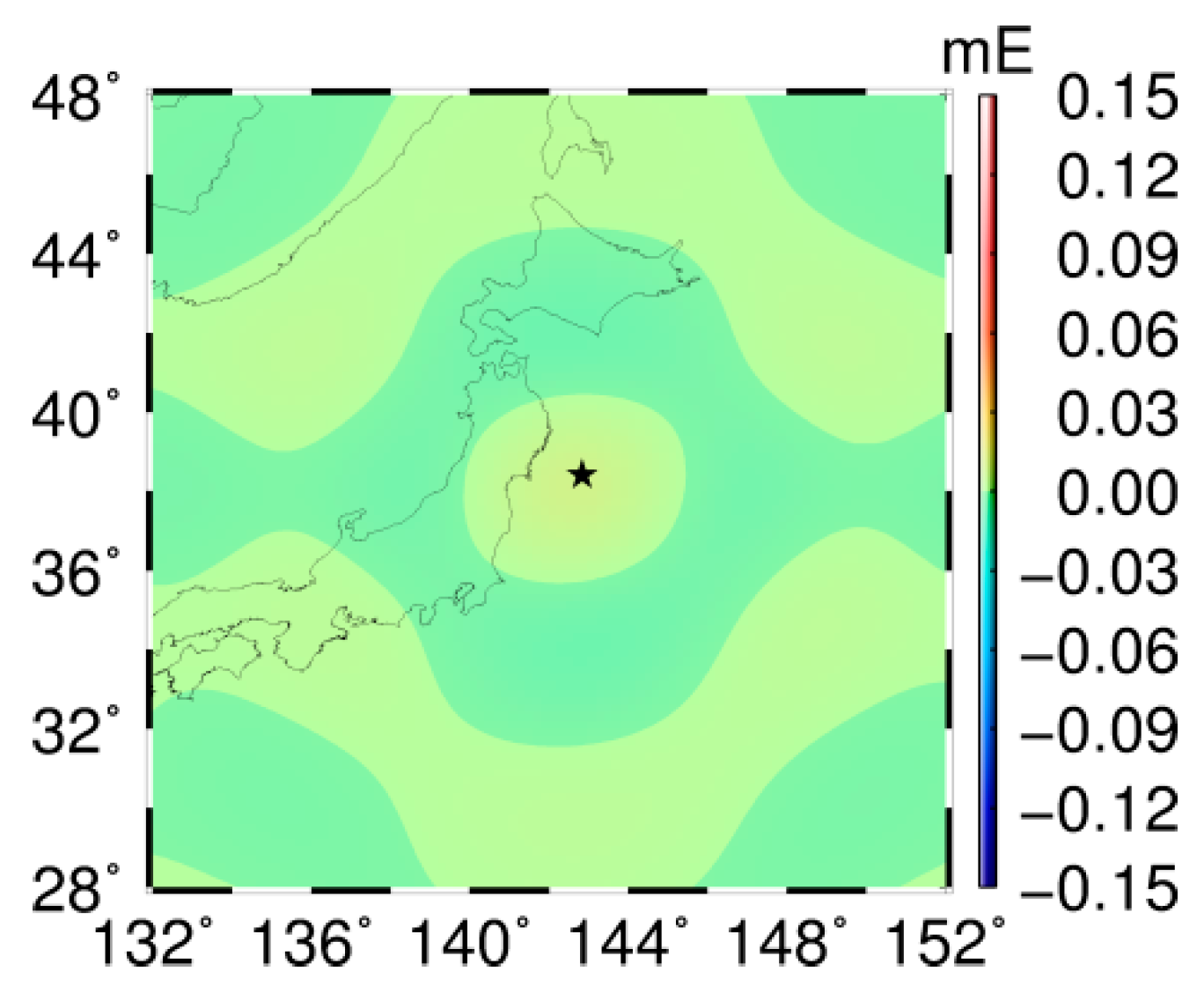

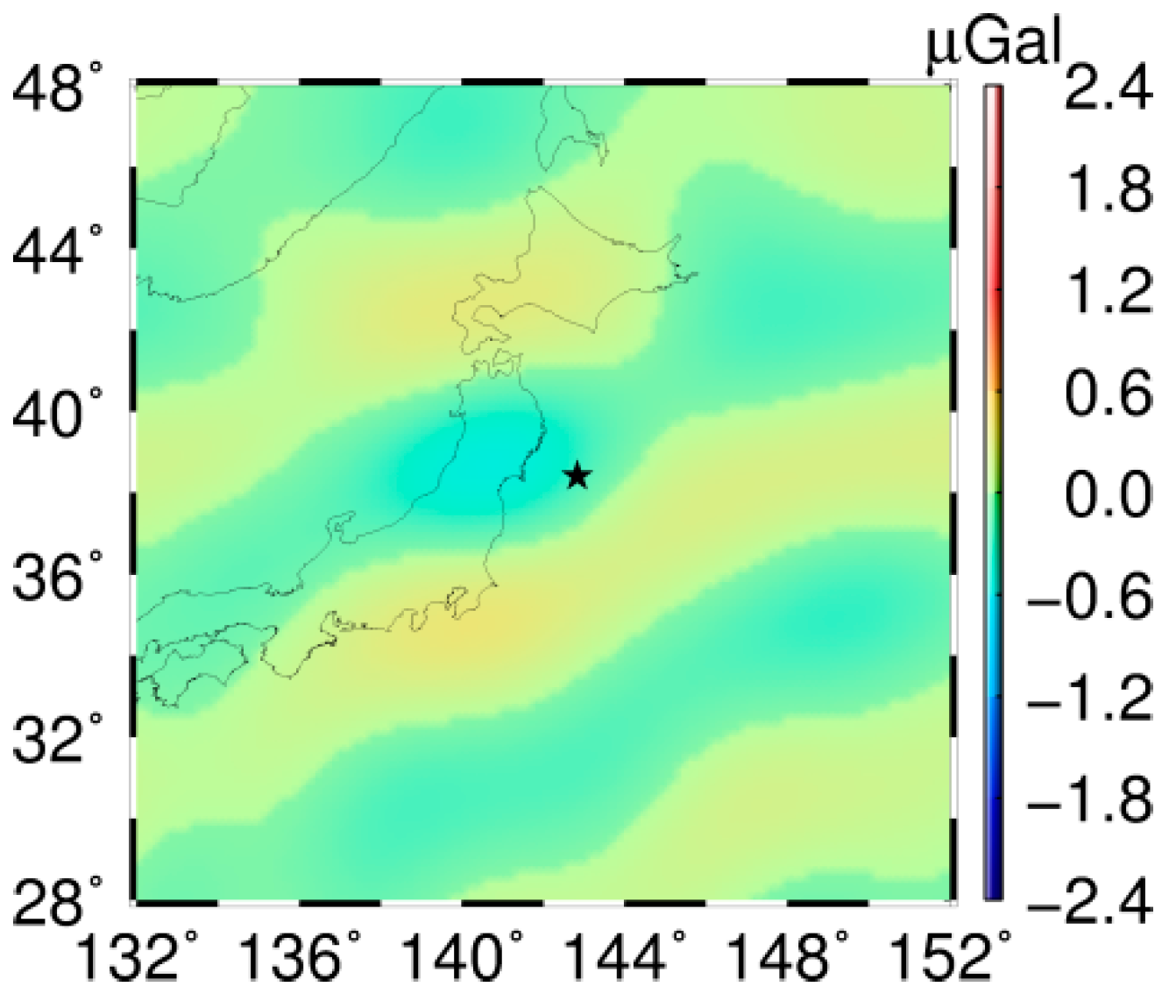

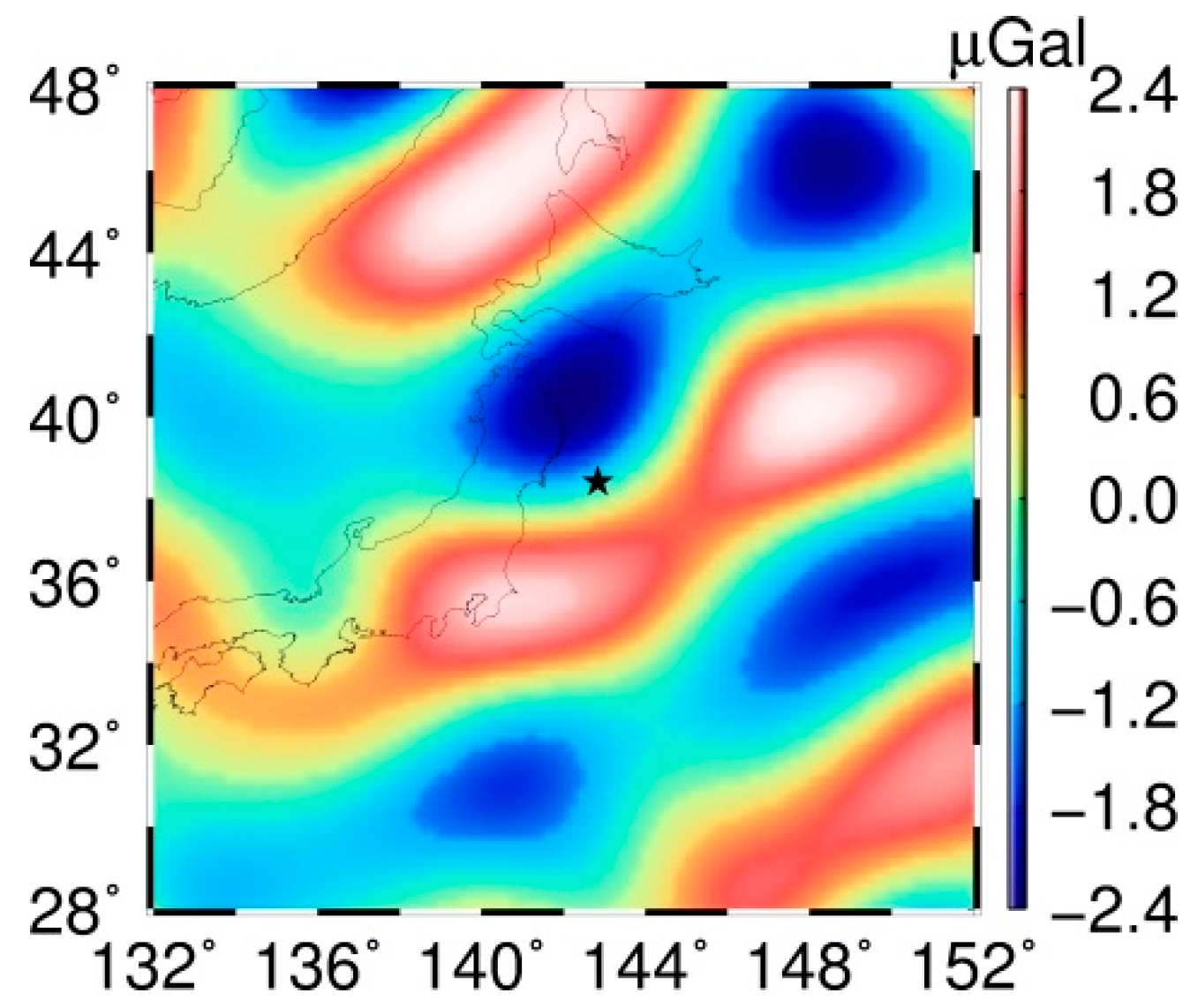

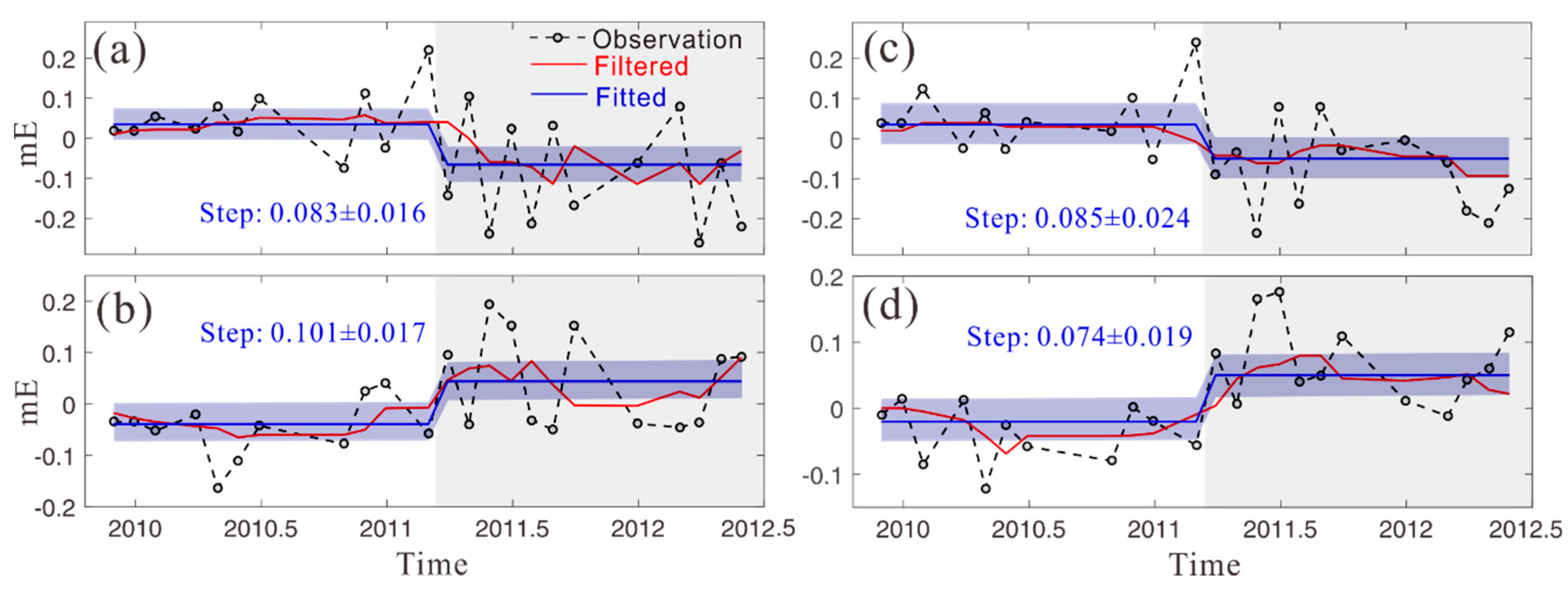
| Depth (km) | Density (ρ) (103 kg/m3) | VP(km/s) | VS(km/s) | Material Type |
|---|---|---|---|---|
| 0–1 | 2.10 | 2.10 | 1.00 | Elastic |
| 1–8 | 2.70 | 6.00 | 3.40 | Elastic |
| 8–15 | 2.90 | 6.60 | 3.70 | Elastic |
| 15–22 | 3.05 | 7.20 | 4.00 | Elastic |
| 22–∞ | 3.40 | 8.20 | 4.70 | Biviscous (Burgers body) |
| GOCE | GRACE | |||||||||
|---|---|---|---|---|---|---|---|---|---|---|
| Quantities | ΔVxx | ΔVyy | ΔVzz | ΔVxz | Δg | ΔVxx | ΔVyy | ΔVzz | ΔVxz | Δg |
| Correlation coefficients | 0.68 | 0.56 | 0.61 | 0.68 | 0.63 | 0.85 | 0.53 | 0.68 | 0.80 | 0.74 |
| RMS of observed signals | 0.044 | 0.041 | 0.078 | 0.056 | 1.179 | 0.010 | 0.005 | 0.015 | 0.012 | 0.179 |
| RMS of differences | 0.038 | 0.036 | 0.066 | 0.047 | 1.043 | 0.007 | 0.012 | 0.015 | 0.008 | 0.158 |
© 2019 by the authors. Licensee MDPI, Basel, Switzerland. This article is an open access article distributed under the terms and conditions of the Creative Commons Attribution (CC BY) license (http://creativecommons.org/licenses/by/4.0/).
Share and Cite
Xu, X.; Ding, H.; Zhao, Y.; Li, J.; Hu, M. GOCE-Derived Coseismic Gravity Gradient Changes Caused by the 2011 Tohoku-Oki Earthquake. Remote Sens. 2019, 11, 1295. https://doi.org/10.3390/rs11111295
Xu X, Ding H, Zhao Y, Li J, Hu M. GOCE-Derived Coseismic Gravity Gradient Changes Caused by the 2011 Tohoku-Oki Earthquake. Remote Sensing. 2019; 11(11):1295. https://doi.org/10.3390/rs11111295
Chicago/Turabian StyleXu, Xinyu, Hao Ding, Yongqi Zhao, Jin Li, and Minzhang Hu. 2019. "GOCE-Derived Coseismic Gravity Gradient Changes Caused by the 2011 Tohoku-Oki Earthquake" Remote Sensing 11, no. 11: 1295. https://doi.org/10.3390/rs11111295







